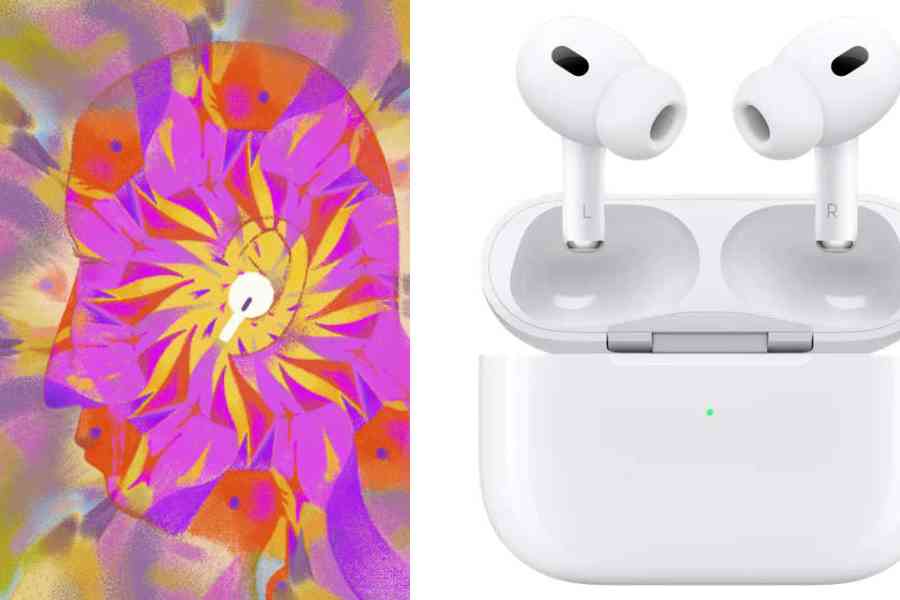In your pocket or purse, you may be toting around small devices that, with the help of new software authorised by the US Food and Drug Administration (FDA), could soon become inexpensive hearing aids. Millions of people already own them.
They’re Apple’s AirPods Pro 2, those white plastic knobs protruding from so many ears in malls and workplaces, on buses and sidewalks. The users may not be among the 30 million American adults reporting some degree of hearing loss; they’re probably just listening to music or podcasts, or talking on their phones.
Within weeks, however, consumers will be able to use those AirPods Pro 2 earbuds to bolster their hearing. Recently, Apple software called Hearing Aid and Hearing Test received a green light from the FDA, a first for the regulatory agency.
With the upcoming software and a compatible iPhone or iPad, users will be able to test their hearing. For those with mild to moderate hearing loss, the AirPods Pro 2 will adjust sounds in their environments and on their devices.
Users will be able to customise their AirPods for volume, tone and balance. All that should allow them to hear better — at least for the devices’ roughly five to six hours of battery life.
Apple plans to release the free software later this fall for iPhones running iOS 18 or later and iPads running iPadOS 18 or later, a spokesperson said. A set of AirPods Pro 2 costs $249 from Apple and less at big box stores or through online retailers.
This is what reformers had in mind when Congress directed the FDA in 2017
to develop regulations for quality over-the-counter hearing aids. The idea was to change the existing gatekeeper model, in which people could acquire prescription aids only through licensed professionals for several thousand dollars a pair. Instead, over-the-
counter hearing aids that could benefit many with hearing loss would be available for a few hundred dollars at any CVS or Walmart, no audiologist or prescription required.
The FDA had three years to develop those regulations; it took five. Finally, two years ago, the hearing health world braced for a transformation — one that still hasn’t quite happened.
“We have no evidence that OTC hearing aids have dramatically changed the hearing market,” said Nicholas Reed, an audiologist and epidemiologist at NYU Langone Health, US.
“Two years in, I would have thought we’d see a nice bump by now” in the number of people owning hearing aids, he added.
But the most recent National Health and Aging Trends study shows that although about two-thirds of Americans in their 70s and older have some degree of hearing loss, less than 30 per cent has hearing aids, a fairly consistent finding. Among Black, Hispanic and low-income seniors, ownership rates are even lower.
“Hearing loss is so gradual, a lot of people don’t realise they have it,” said Andy Sabin, a hearing scientist and scientific consultant to HearAdvisor, which tests and evaluates hearing aids.
In fact, a regular survey by the Hearing Industries Association shows that it takes years for people who recognise they have hearing difficulties to buy a hearing aid, if they do at all.
But perhaps because of recent educational campaigns, that delay in seeking treatment has shrunk, from six years in the 2019 survey to four years in 2022. And now the entrance of Apple, a high-profile consumer company, into the OTC market might hasten such changes.
“That moment when they hear better” — and realise that birds are chirping outside the window — “a light goes on. And now that moment will be so much more accessible”, Sabin said. He anticipates that more manufacturers and software developers will follow Apple’s lead.
“We expect lots of other companies will also introduce hearing aid features in their earbuds,” he added. (In his day job, Sabin is an engineer at Bose, whose technology is already used in a brand of OTC hearing aids.)
Concern about older Americans’ hearing reflects a wave of research showing how crucial it is to physical and cognitive health. In 2020, a Lancet commission identified untreated hearing loss as the single greatest potentially modifiable risk factor for dementia.
Last year, researchers reported that among study participants who were older and less affluent, and thus more at risk, hearing aid use slowed the rate of cognitive decline by 48 per cent over three years. Untreated hearing loss also increases the risks of social isolation and depression, and it is associated with falls.
Though consumers can’t try the new software yet, Apple is “a well-known, trusted company” with global brand awareness, Reed added. That might induce more people with mild to moderate hearing loss — the cohort the Apple software is intended for — to become de facto hearing aid owners.
Another advantage: earbud use isn’t age-specific, possibly reducing the stigma of conventional hearing aids. Nobody will know whether an earbud wearer is listening to Arcade Fire or trying to understand a conversation.
NYTNS









